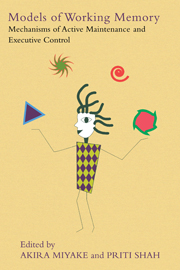Book contents
- Frontmatter
- Contents
- List of Contributors
- Dedication
- Preface
- Ode on Working Memory
- Acknowledgments
- 1 Models of Working Memory: An Introduction
- 2 Working Memory: The Multiple-Component Model
- 3 An Embedded-Processes Model of Working Memory
- 4 Individual Differences in Working Memory Capacity and What They Tell Us About Controlled Attention, General Fluid Intelligence, and Functions of the Prefrontal Cortex
- 5 Modeling Working Memory in a Unified Architecture: An ACT-R Perspective
- 6 Insights into Working Memory from the Perspective of the EPIC Architecture for Modeling Skilled Perceptual-Motor and Cognitive Human Performance
- 7 The Soar Cognitive Architecture and Human Working Memory
- 8 Long-Term Working Memory as an Alternative to Capacity Models of Working Memory in Everyday Skilled Performance
- 9 Interacting Cognitive Subsystems: Modeling Working Memory Phenomena Within a Multiprocessor Architecture
- 10 Working Memory in a Multilevel Hybrid Connectionist Control Architecture (CAP2)
- 11 A Biologically Based Computational Model of Working Memory
- 12 Models of Working Memory: Eight Questions and Some General Issues
- 13 Toward Unified Theories of Working Memory: Emerging General Consensus, Unresolved Theoretical Issues, and Future Research Directions
- Name Index
- Subject Index
1 - Models of Working Memory: An Introduction
Published online by Cambridge University Press: 05 June 2012
- Frontmatter
- Contents
- List of Contributors
- Dedication
- Preface
- Ode on Working Memory
- Acknowledgments
- 1 Models of Working Memory: An Introduction
- 2 Working Memory: The Multiple-Component Model
- 3 An Embedded-Processes Model of Working Memory
- 4 Individual Differences in Working Memory Capacity and What They Tell Us About Controlled Attention, General Fluid Intelligence, and Functions of the Prefrontal Cortex
- 5 Modeling Working Memory in a Unified Architecture: An ACT-R Perspective
- 6 Insights into Working Memory from the Perspective of the EPIC Architecture for Modeling Skilled Perceptual-Motor and Cognitive Human Performance
- 7 The Soar Cognitive Architecture and Human Working Memory
- 8 Long-Term Working Memory as an Alternative to Capacity Models of Working Memory in Everyday Skilled Performance
- 9 Interacting Cognitive Subsystems: Modeling Working Memory Phenomena Within a Multiprocessor Architecture
- 10 Working Memory in a Multilevel Hybrid Connectionist Control Architecture (CAP2)
- 11 A Biologically Based Computational Model of Working Memory
- 12 Models of Working Memory: Eight Questions and Some General Issues
- 13 Toward Unified Theories of Working Memory: Emerging General Consensus, Unresolved Theoretical Issues, and Future Research Directions
- Name Index
- Subject Index
Summary
Working memory plays an essential role in complex cognition. Everyday cognitive tasks – such as reading a newspaper article, calculating the appropriate amount to tip in a restaurant, mentally rearranging furniture in one's living room to create space for a new sofa, and comparing and contrasting various attributes of different apartments to decide which to rent – often involve multiple steps with intermediate results that need to be kept in mind temporarily to accomplish the task at hand successfully. “Working memory” is the theoretical construct that has come to be used in cognitive psychology to refer to the system or mechanism underlying the maintenance of task-relevant information during the performance of a cognitive task (Baddeley & Hitch, 1974; Daneman & Carpenter, 1980). As reflected by the fact that it has been labeled “the hub of cognition” (Haberlandt, 1997, p. 212) and proclaimed as “perhaps the most significant achievement of human mental evolution” (Goldman-Rakic, 1992, p. 111), it is a central construct in cognitive psychology and, more recently, cognitive neuroscience.
Despite the familiarity of the term, however, it is not easy to figure out what working memory really is. To begin with, the term working memory is used in quite different senses by different communities of researchers. In the behavioral neuroscience and animal behavior fields, for example, the term is associated with the radial arm maze paradigm.
Information
- Type
- Chapter
- Information
- Models of Working MemoryMechanisms of Active Maintenance and Executive Control, pp. 1 - 27Publisher: Cambridge University PressPrint publication year: 1999
Accessibility standard: Unknown
Why this information is here
This section outlines the accessibility features of this content - including support for screen readers, full keyboard navigation and high-contrast display options. This may not be relevant for you.Accessibility Information
- 63
- Cited by
